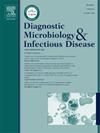Cross-reactivity mediated by SARS-CoV-2 antibodies: Mechanism and impact of elevated HIV ELISA false-positive rates in the late-phase COVID-19 pandemic
IF 1.8
4区 医学
Q3 INFECTIOUS DISEASES
Diagnostic microbiology and infectious disease
Pub Date : 2025-08-28
DOI:10.1016/j.diagmicrobio.2025.117088
引用次数: 0
Abstract
This study analyzed the correlation between false-positive HIV ELISA results (using Bio-Rad reagents) and SARS-COV-2 antibody levels in 301 unpaid apheresis platelet donors with prior infection or vaccination, enrolled from Zhejiang Blood Center between February 1 and May 31, 2023. Trends in both the HIV ELISA false-positive rate and SARS-COV-2 antibody levels were assessed. The false-positive rate rose in early 2023, peaking at 0.68 % in mid-February, before gradually declining to the historical baseline of approximately 0.1 % by May's end. Similarly, donor SARS-COV-2 antibody levels peaked in February and subsequently decreased. Correlation analysis revealed a strong positive correlation (P<0.01) between HIV ELISA false-positive rates and SARS-CoV-2 antibody levels. The findings indicate a positive correlation, suggesting antibody cross-reactivity, likely mediated by structural similarities and shared epitopes between SARS-CoV-2 spike proteins and HIV-1 antigens (especially the p24 antigen in fourth-generation assays). The study recommends that significant fluctuations in false-positive rates warrant investigation into specific causes, including reagent issues. These findings underscore the need for continuous monitoring of false-positive results in HIV screening during pandemics. Improving reagent specificity and implementing rapid donor re-entry procedures are essential to safeguard blood supply efficiency and maintain donor trust.
SARS-CoV-2抗体介导的交叉反应性:COVID-19大流行后期HIV ELISA假阳性率升高的机制及影响
本研究分析了2023年2月1日至5月31日在浙江省血液中心招募的301例既往感染或接种过疫苗的无偿采血小板献血者的HIV ELISA假阳性结果(使用Bio-Rad试剂)与SARS-COV-2抗体水平的相关性。评估HIV ELISA假阳性率和SARS-COV-2抗体水平的变化趋势。假阳性率在2023年初上升,在2月中旬达到0.68%的峰值,然后在5月底逐渐下降到约0.1%的历史基线。同样,供体SARS-COV-2抗体水平在2月份达到峰值,随后下降。相关分析显示HIV ELISA假阳性率与SARS-CoV-2抗体水平呈正相关(P<0.01)。研究结果表明两者呈正相关,表明抗体交叉反应性可能是由SARS-CoV-2刺突蛋白和HIV-1抗原(特别是第四代检测中的p24抗原)之间的结构相似性和共享表位介导的。该研究建议,假阳性率的显著波动需要调查具体原因,包括试剂问题。这些发现强调了在大流行期间持续监测艾滋病毒筛查假阳性结果的必要性。提高试剂特异性和实施快速献血者再入程序对于保障血液供应效率和维护献血者信任至关重要。
本文章由计算机程序翻译,如有差异,请以英文原文为准。
求助全文
约1分钟内获得全文
求助全文
来源期刊
CiteScore
5.30
自引率
3.40%
发文量
149
审稿时长
56 days
期刊介绍:
Diagnostic Microbiology and Infectious Disease keeps you informed of the latest developments in clinical microbiology and the diagnosis and treatment of infectious diseases. Packed with rigorously peer-reviewed articles and studies in bacteriology, immunology, immunoserology, infectious diseases, mycology, parasitology, and virology, the journal examines new procedures, unusual cases, controversial issues, and important new literature. Diagnostic Microbiology and Infectious Disease distinguished independent editorial board, consisting of experts from many medical specialties, ensures you extensive and authoritative coverage.

 求助内容:
求助内容: 应助结果提醒方式:
应助结果提醒方式:


